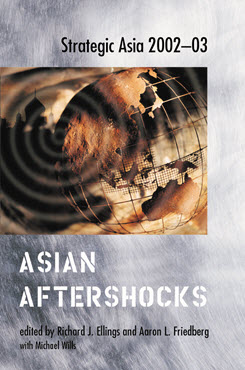Introduction (Strategic Asia 2002-03)
Developments in the months following the September 11 attacks reaffirmed tenets expressed in these pages one year ago: America has enormous and growing stakes in Asia and Asia increasingly functions as a zone of strategic interaction, with countries across the region acutely sensitive to each other’s power and perceived intentions. How this zone evolves is of great importance to the United States.
The September 11 terrorist attacks against the World Trade Center and the Pentagon constituted a strategic event of seismic proportions. Commentators and analysts soon began to speak of a new era, one in which everything seemed to have changed—diplomatic priorities, the economy, and threat assessments (including the possibility of attacks by weapons of mass destruction) as the Bush administration declared war on international terrorism.
Consequently, the “tectonic plates” of Strategic Asia began to shift. The United States and Russia redefined their bilateral relationship, with important repercussions for integrating Russia into Europe, development of a U.S. national missile defense (NMD) system, and close collaboration in the war on terrorism. To a far greater extent than ever before, the United States became deeply engaged across South Asia—working with both India and Pakistan simultaneously—and within several months Washington opened a second front against Islamist terrorist groups in Southeast Asia. Conspicuously, the events of September 11 jolted, but did not cause any significant strategic movement among, the major powers located in Northeast Asia. Japan sought to help in the war on terrorism within the narrow confines of its political constraints, while China did little more than tolerate America’s new presence on its western border. Among the most visible effects of the war on terrorism was a significant increase in direct U.S. military engagement in Asia. In the weeks following the attacks, Washington pulled together a loose international coalition of states willing to support its efforts to destroy the Al Qaeda network in Afghanistan. By the time the primary military campaign concluded in December 2001, with the collapse of the Taliban regime, U.S. military personnel were stationed in Afghanistan and Pakistan and in Kyrgyzstan and Uzbekistan in Central Asia—the first ever U.S. military presence in that region—and were supported by two aircraft carrier battle groups in the Arabian Sea. By January 2002, U.S. forces had also been deployed to the Philippines—10 years after the closure of U.S. military bases there—to assist Manila in its campaign against the Abu Sayyaf group.
Developments in the months following the September 11 attacks reaffirmed tenets expressed in these pages one year ago: America has enormous and growing stakes in Asia and Asia increasingly functions as a zone of strategic interaction, with countries across the region acutely sensitive to each other’s power and perceived intentions. How this zone evolves is of great importance to the United States. The increasing concentration and yet differing rates of growth of national economic and military capabilities in Asia, the region’s demographic minance, and its long-standing history of rivalries and grievances all suggest that the most significant challenges to peace and security in the coming century are likely to arise in Strategic Asia. Moreover, the cultural divide exploited by Al Qaeda terrorists extends from the Middle East through South Asia and across Southeast Asia to the largest Muslim country of all, Indonesia.
Strategic Asia
The Strategic Asia annual edited volume incorporates assessments of economic, political, and military trends and focuses on the strategies that drive policy in the region. Learn more about Strategic Asia.


